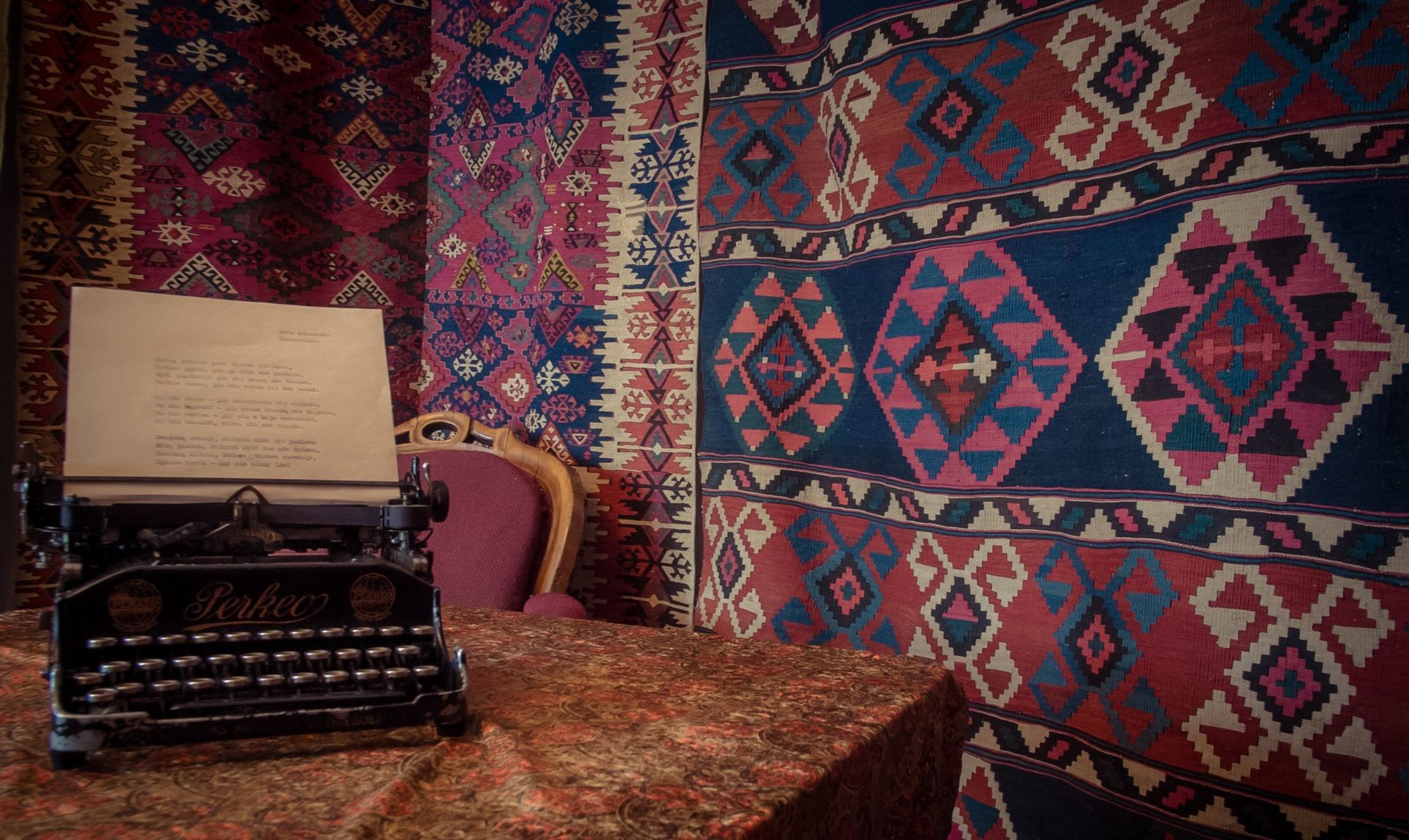The gallery, a marble building in
manorial style, is located near famous "Pod Jedlami" villa
and was built in early 1920s by Koziański family. After the World
War II the house was bought from heirs by the Council of Ministers.
Koziański's villa became a representative object, often visited by
prominent politicians of PRL (Polish People's Republic), i.a. by
Józef Cyrankiewicz, thus it was known commonly as
"Cyrankiewiczówka". In 1981, thanks to the local
Solidarność movement, the building was given to the Museum, aiming
for Eastern Carpets Gallery, which were earlier donated by Jerzy
Kulczycki's widow, Anna Piotrowicz-Kulczycka.
Collection's origins reach back to
1906, when Włodzimierz Kulczycki (1862-1936), professor and later
rector of Lviv Veterynary Academy, bought first exhibits. Collecting
oriental fabrics and carpets was scientific at first; Kulczycki
obtained literature on carpets and systematicaly learned about this
field of Eastern material culture. He himself was an author of many
articles on carpets. During the interwar period, Włodzimierz
Kulczycki's collection was repeatetly presented on ehxibitions. His
son Jerzy (1898-1974), PhD in philosophy and art historian, took the
same fondness of collecting, as after the interwar period he
gradually increased the set, being loyal to father's concept of
resticting collection to carpets from every nation of Anatolia,
Central Asia, Iran and Caucasus.
During the World War II period, the
collection didn't had any major losses. In 1946, when Pole's
repatriation has begun, Kulczycki found himself in Warsaw and
maintained connection with Warsaw University. Thanks to support of
many people, the collection was saved and stored under the double
floor of Kulczycki's one-room flat. Because of Jerzy's health
condition, the family moved to Podhale region. Before that though, it
was decited to split the collection and sell its part to Wawel in
Cracov, where 64 luxorious and palatial objects were moved. No less
valuable, folk carpets were transported to Murzasichle in Podhale,
where Kulczycki family built a house. According to her hubsand's last
will, Anna Piotrowicz-Kulczycka donated the gift to the nation and
entrusted it to the Tatra Museum.
The first time this part of the
collection was shown was in Art Exhibition Bureau in Zakopane in
1978. After it reached Koziniec Gallery, its exhibited annualy,
mostly in summer. The collection consists of 65 objects – carpets
and cloths coming from many regions and nations of Asia: Ian,
Turkestan, Afghanistan, Western Asia, Caucasus. Carpets and cloths
bring delight with their subtlety and harmony of colors, richness and
mysterious symbolism of ornaments.
Another collection which found its
place in Kulczycki Gallery is of paintings and graphics of
contemporary artist, Marek Żuławski, donated by widow Maryla
Żuławska in 1986. Marek Żuławski (1908-1985), son of Jerzy
Żuławski and Kazimiera from house Hanicki, spent his childhood in
Zakopane, where his family lived in Łada villa till 1920. Many
prominent writers, poets and painters met in Żuławski's salon:
Kazimierz Tetmajer, Jan Kasprowicz, Leopold Staff, Władysław Orkan
Tymon Niesiołowski, Artur Rubinstein, Stanisław Ignacy Witkiewicz,
Władysław Reymont, Stanisław Przybyszewski, Tadeusz Boy-Żeleński,
Kazimierz Sichulski. The youth of Marek Żuławski and his brothers,
Juliusz and Wawrzyniec (died in Alps) passed under mountain-climbing,
as they were first to reach many Tatra peaks. Marek Żuławski's
painting talents revealed themselves in his final junior high years.
After finishing junior high school in Toruń, where his family
relocated from Zakopane, he moved to Warsaw and started studing in
the Academy of Fine Arts under professors Tichy, Kowarski and
Pękalski. After graduating he moved abroad in 1935. Two years later
he settled down in London, where he lived until the end of his life.
In his Autoportrait, a literary memoir, he himself describes his art
with outstanding accuracy:
"My painting is full of
allusions. Its goal is to create mood and atmosphere which provokes
thought. I wish for painting to be something more than arithmetic sum
of its parts, to be a symbol or visual representation of experience.
It's about expressing your worldview, about telling something which
cannot be told by other means than painting. It's about creating new
image of a man in today's context."
Kulczycki Gallery answers mosty to Art
Department. Here the collections not included in permanent
exhibitions are exposed. These are thematic series like Tatra
landscapes, Tatra and Podhale in watercolors or portrait from Tatra
Museum stocks. But this is also a place of etnographic and nature
exhibtions, as well as ski history displays. In 1996 in Kulczycki
Gallery, the first monographic exposition of Stanisław Witkiewicz's
art was presented. Year later due to visit of John Paul II, the old
glass painting from Tatra Museum exhibition was opened. In 1998
visitors could see Jewels of Dzieduszycki Ordination natural
exhibition, imported from Lviv. The Gallery also hosted Zakopane
editions of larger exhibitions made by National Museums in Warsaw and
Cracov: Tadeusz Brzozowski. Paintings between Giewont and Parnassus,
Podhale folk inspirations, The World of Lela Pawlikowska, Rafał
Malczewski and the myth of Zakopane, Halny Wind. Tatra paintings and
impressions.
Opening hours
wednesday – saturday from 10.00 to
18.00
sunday from 9.00 to 15.00
Contact
Droga na Koziniec 8 street
34-500 Zakopane
phone +48 18 20
129 36
muzeumtatrzanskie.pl
 Umiarkowana
Umiarkowana





